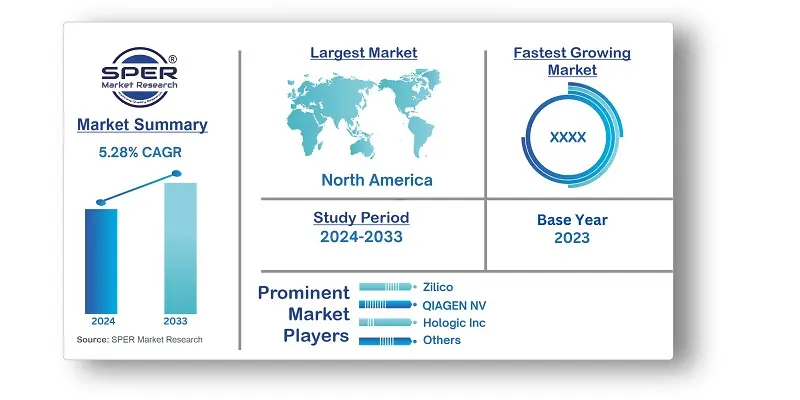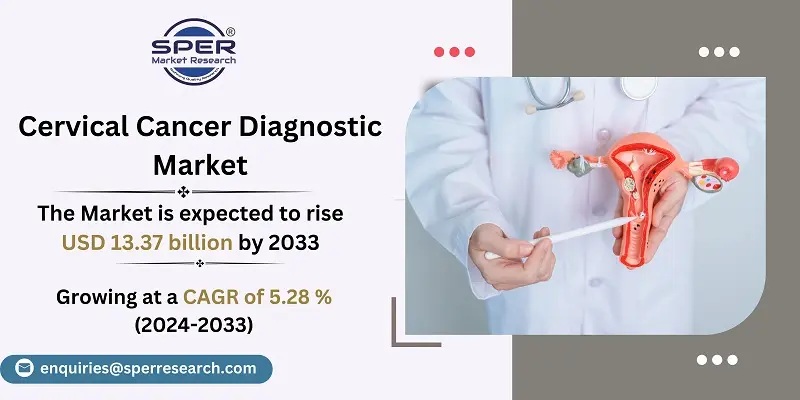
Cervical Cancer Diagnostic Market Growth, Size, Trends, Share, Revenue, Scope and Future Outlook
Cervical Cancer Diagnostic Market Size- By Diagnostic Test, By Age Group, By End User- Regional Outlook, Competitive Strategies and Segment Forecast to 2033
| Published: Apr-2024 | Report ID: HLCA2447 | Pages: 1 - 205 | Formats*: |
| Category : Healthcare | |||
- The World Health Organization published updated recommendations for cervical cancer screening and care in July 2021. The revised guidelines state that screening for women in the general public should start at age thirty. Every five to ten years, routine screening with a validated HPV test is recommended. However, screening for HIV should begin at age 25 and be repeated every three to five years for women who are living with the virus. HPV DNA testing can be applied as a stand-alone test or in conjunction with other screening techniques to treat the infection. Based on the most recent data regarding the efficacy of cervical cancer screening and treatment, these new recommendations have been made. Their goal is to make them more affordable and available to women worldwide.
- Low-cost DNA testing for HPV infections may increase access to cervical cancer screening, according to a June 23, 2023, LabMedica report. Bioengineers at Rice University have created an inexpensive point-of-care DNA test for HPV infections. The test may increase access to cervical cancer screening in low- and middle-income nations, where the illness claims the lives of over 300,000 women annually.
- F. Hoffmann-La Roche Ltd., a multinational healthcare business based in Switzerland, declared in June 2022 that a “human papillomavirus (HPV) self-sampling solution†would be made available in territories that accept the CE mark. The primary use of this test kit is for HPV screening, which identifies women who may be at risk of cervical cancer.


| Report Metric | Details |
| Market size available for years | 2020-2033 |
| Base year considered | 2023 |
| Forecast period | 2024-2033 |
| Segments covered | By Diagnostic Test, By Age Group, By End User |
| Regions covered | North America, Asia-Pacific, Latin America, Middle East & Africa and Europe |
| Companies Covered | Zilico, Siemens Healthineers AG, QIAGEN NV, Abbott Laboratories, Becton, Dickinson and Co, Quest Diagnostics Inc, F. Hoffmann-La Roche Ltd, Guided Therapeutics, Hologic Inc, Bio-Rad Laboratories. |
- Healthcare Providers
- Gynecologists and obstetricians
- Pathologists
- Government Health agencies and policymakers
- Medical Laboratories
- Research institutions
| By Diagnostic Test: |
|
| By Age Group: |
|
| By Vertical: |
|
- Global Cervical Cancer Diagnostic Market Size (FY’2024-FY’2033)
- Overview of Global Cervical Cancer Diagnostic Market
- Segmentation of Global Cervical Cancer Diagnostic Market By Diagnostic Test (Pap Smear Tests, HPV Test, Biopsy and ECC, Colposcopy Tests, Others)
- Segmentation of Global Cervical Cancer Diagnostic Market By Age Group (20 to 40 years, above 40 years)
- Segmentation of Global Cervical Cancer Diagnostic Market By End User (Hospitals, Speciality Clinics, Cancer and Radiation Therapy Centers, Diagnostic Centers, Others)
- Statistical Snap of Global Cervical Cancer Diagnostic Market
- Expansion Analysis of Global Cervical Cancer Diagnostic Market
- Problems and Obstacles in Global Cervical Cancer Diagnostic Market
- Competitive Landscape in the Global Cervical Cancer Diagnostic Market
- Impact of COVID-19 and Demonetization on Global Cervical Cancer Diagnostic Market
- Details on Current Investment in Global Cervical Cancer Diagnostic Market
- Competitive Analysis of Global Cervical Cancer Diagnostic Market
- Prominent Players in the Global Cervical Cancer Diagnostic Market
- SWOT Analysis of Global Cervical Cancer Diagnostic Market
- Global Cervical Cancer Diagnostic Market Future Outlook and Projections (FY’2024-FY’2033)
- Recommendations from Analyst
1.1. Scope of the report1.2. Market segment analysis
2.1. Research data source2.1.1. Secondary Data2.1.2. Primary Data2.1.3. SPER’s internal database2.1.4. Premium insight from KOL’s2.2. Market size estimation2.2.1. Top-down and Bottom-up approach2.3. Data triangulation
4.1. Driver, Restraint, Opportunity and Challenges analysis4.1.1. Drivers4.1.2. Restraints4.1.3. Opportunities4.1.4. Challenges4.2. COVID-19 Impacts of the Global Cervical Cancer Diagnostic Market.
5.1. SWOT Analysis5.1.1. Strengths5.1.2. Weaknesses5.1.3. Opportunities5.1.4. Threats5.2. PESTEL Analysis5.2.1. Political Landscape5.2.2. Economic Landscape5.2.3. Social Landscape5.2.4. Technological Landscape5.2.5. Environmental Landscape5.2.6. Legal Landscape5.3. PORTER’s Five Forces5.3.1. Bargaining power of suppliers5.3.2. Bargaining power of buyers5.3.3. Threat of Substitute5.3.4. Threat of new entrant5.3.5. Competitive rivalry5.4. Heat Map Analysis
6.1. Global Cervical Cancer Diagnostic Market Manufacturing Base Distribution, Sales Area, Product Type6.2. Mergers & Acquisitions, Partnerships, Product Launch, and Collaboration in Global Cervical Cancer Diagnostic Market
7.1. Global Cervical Cancer Diagnostic Market Size, Share and Forecast, By Diagnostic Test, 2020-20267.2. Global Cervical Cancer Diagnostic Market Size, Share and Forecast, By Diagnostic Test, 2027-20337.3. Pap Smear Tests7.4. HPV Test7.5. Biopsy and ECC7.6. Colposcopy Tests7.7. Others
8.1. Global Cervical Cancer Diagnostic Market Size, Share and Forecast, By Age Group, 2020-20268.2. Global Cervical Cancer Diagnostic Market Size, Share and Forecast, By Age Group, 2027-20338.3. 20 to 40 years8.4. above 40 years
9.1. Global Cervical Cancer Diagnostic Market Size, Share and Forecast, By End User, 2020-20269.2. Global Cervical Cancer Diagnostic Market Size, Share and Forecast, By End User, 2027-20339.3. Hospitals9.4. Specialty Clinics9.5. Cancer and Radiation Therapy Centers9.6. Diagnostic Centers9.7. Others
10.1. Global Cervical Cancer Diagnostic Market Size and Market Share
11.1. Global Cervical Cancer Diagnostic Market Size and Market Share By Region (2020-2026)11.2. Global Cervical Cancer Diagnostic Market Size and Market Share By Region (2027-2033)11.3. Asia-Pacific11.3.1. Australia11.3.2. China11.3.3. India11.3.4. Japan11.3.5. South Korea11.3.6. Rest of Asia-Pacific11.4. Europe11.4.1. France11.4.2. Germany11.4.3. Italy11.4.4. Spain11.4.5. United Kingdom11.4.6. Rest of Europe11.5. Middle East and Africa11.5.1. Kingdom of Saudi Arabia11.5.2. United Arab Emirates11.5.3. Qatar11.5.4. South Africa11.5.5. Egypt11.5.6. Morocco11.5.7. Nigeria11.5.8. Rest of Middle-East and Africa11.6. North America11.6.1. Canada11.6.2. Mexico11.6.3. United States11.7. Latin America11.7.1. Argentina11.7.2. Brazil11.7.3. Rest of Latin America
12.1. Zilico12.1.1. Company details12.1.2. Financial outlook12.1.3. Product summary12.1.4. Recent developments12.2. Siemens Healthineers AG12.2.1. Company details12.2.2. Financial outlook12.2.3. Product summary12.2.4. Recent developments12.3. QIAGEN NV12.3.1. Company details12.3.2. Financial outlook12.3.3. Product summary12.3.4. Recent developments12.4. Abbott Laboratories12.4.1. Company details12.4.2. Financial outlook12.4.3. Product summary12.4.4. Recent developments12.5. Becton, Dickinson and Co.12.5.1. Company details12.5.2. Financial outlook12.5.3. Product summary12.5.4. Recent developments12.6. Quest Diagnostics Inc.12.6.1. Company details12.6.2. Financial outlook12.6.3. Product summary12.6.4. Recent developments12.7. F. Hoffmann-La Roche Ltd.12.7.1. Company details12.7.2. Financial outlook12.7.3. Product summary12.7.4. Recent developments12.8. Guided Therapeutics12.8.1. Company details12.8.2. Financial outlook12.8.3. Product summary12.8.4. Recent developments12.9. Hologic Inc.12.9.1. Company details12.9.2. Financial outlook12.9.3. Product summary12.9.4. Recent developments12.10. Bio-Rad Laboratories Inc.12.10.1. Company details12.10.2. Financial outlook12.10.3. Product summary12.10.4. Recent developments12.11. Others
SPER Market Research’s methodology uses great emphasis on primary research to ensure that the market intelligence insights are up to date, reliable and accurate. Primary interviews are done with players involved in each phase of a supply chain to analyze the market forecasting. The secondary research method is used to help you fully understand how the future markets and the spending patterns look likes.
The report is based on in-depth qualitative and quantitative analysis of the Product Market. The quantitative analysis involves the application of various projection and sampling techniques. The qualitative analysis involves primary interviews, surveys, and vendor briefings. The data gathered as a result of these processes are validated through experts opinion. Our research methodology entails an ideal mixture of primary and secondary initiatives.



Frequently Asked Questions About This Report
PLACE AN ORDER
Year End Discount
Sample Report
Pre-Purchase Inquiry
NEED CUSTOMIZATION?
Request CustomizationCALL OR EMAIL US
100% Secure Payment






Related Reports
Our Global Clients
Our data-driven insights have influenced the strategy of 200+ reputed companies across the globe.




















